House with hi-tech elements for a homeless cat
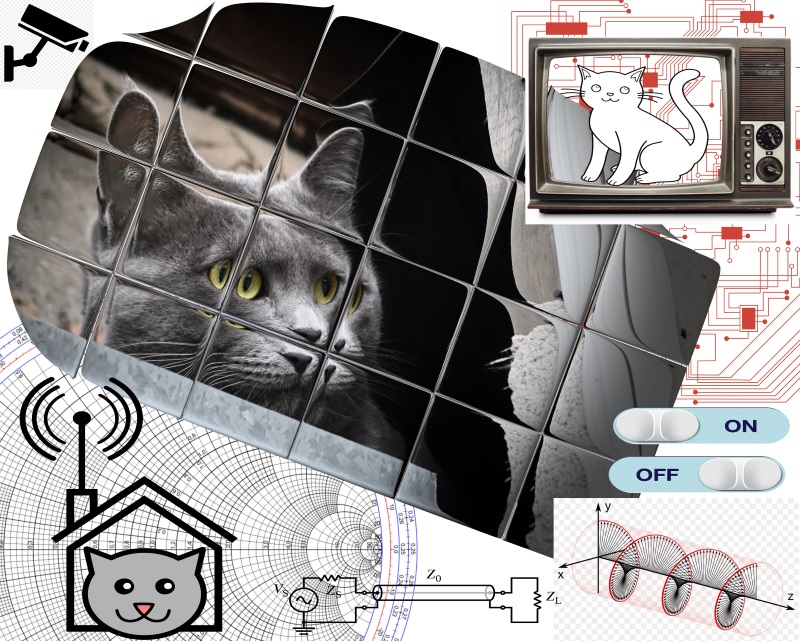
Recently I noticed that a skinny and very shy cat, with always sad eyes, settled in the barn attic ...

He did not make contact, but from a distance he was watching us. I decided to treat him with premium-class feeding, which our home cat muzzles eat. Even after two months of treats, the cat still avoided all attempts to contact him. Perhaps earlier he inherited from people, which led to such timidity.
As the saying goes, since Mohammed does not go to the mountain, the mountain itself will come to Magomed. In connection with the upcoming change of season and the inevitable cooling, I decided to bungle him with a kind of "house", with the placement of thereof in his territory there, that is, in the attic.
The base of the house is a couch from a double box from Hainan mangoes. Double, this is when the box is inserted into the inverted lid from it. Each of the halves is double, so the box is quadrupled, of increased strength. The Chinese know a lot about boxes, as the size is perfect for cats. :) Between the layers in the box I laid a lining from the laminate, for additional thermal insulation. Then he put 2 layers of centimeter foam on the bottom, and on top - a triple folded, old, terry towel.
Knowing what is the “milk step” with the release of claws, and how any bedding will be crumpled over time, I sewed all three layers of the towel right through to the box. And I sewn it not with threads, which can easily be cracked or torn by claws, but with a copper (winding) wire in varnish insulation, already 1.2 mm thick. Yes, severely, but for that anti-vandal, from cat's claws or teeth.
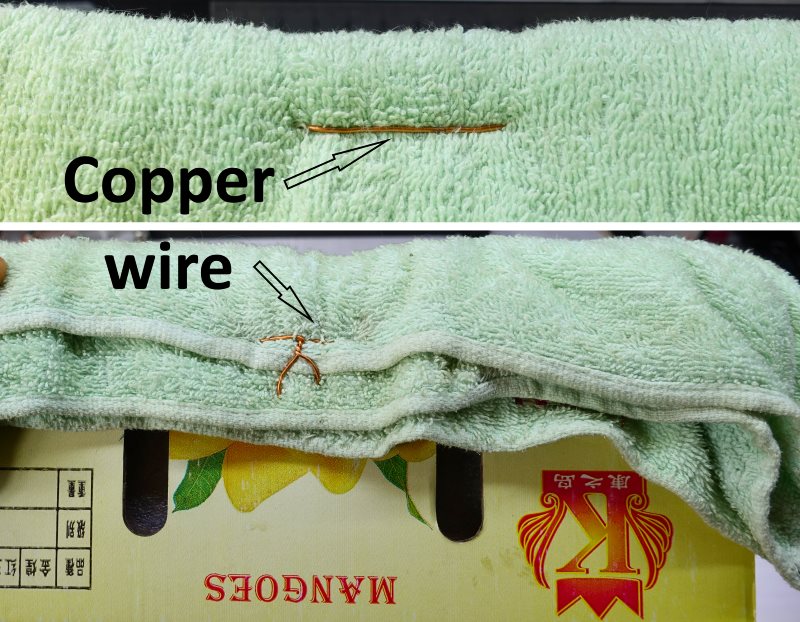
I flashed all the corners in a similar way so that the litter could withstand its laying form, even despite any bullying by the settler.
But it’s not enough just to put a soft couch, because in the attic in winter frosty drafts walk, with the same temperature as on the street. So, there was a task to create around the crib, something like a "dome", to keep the heat coming from the cat. For this, the prepared couch was placed inside a larger box.
On the side wall of the outer box I cut a semblance of a “door”, a self-closing passage, so that the heat would not break out much.
As the work progressed, home companions several times managed to try on such a soft, comfortable home:
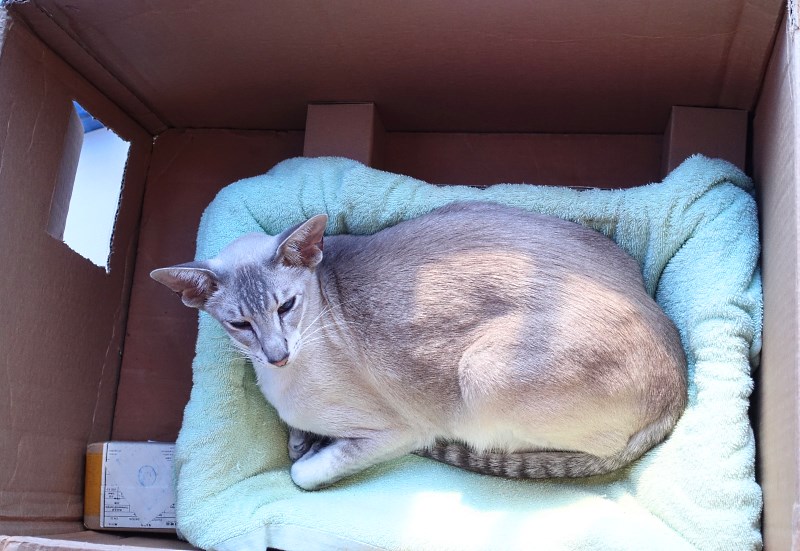
They terribly liked to gently stomp in a couch, from which within 5 minutes everyone immediately crushed to sleep:
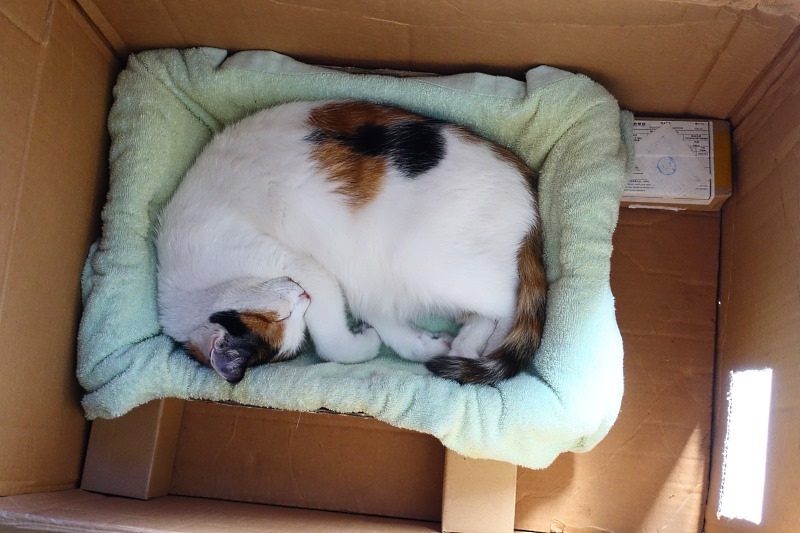
Well, well, if we keep the temperature around the tenant by means of an externally closed perimeter, then why not generate heat right there so that the tenant cat can save heat loss in his body. To do this, two more layers of thick cardboard with thermal insulation were placed at the bottom of a large box, between the layers of which two active, thermo-heating elements from a multicore, constantan cable were laid. They were designed for power from USB, that is, 5 volts. Combining them in series, I remade them for power from 9 - 10 volts, with a consumption current of about 1 Ampere, which would give us a heating pad power of 9-10 watts. And this is already a lot, for such a small heating volume.

Since the animal is a priori illiterate, it could theoretically cut through the power supply cable for the heating pad in the box. And if so, then you should think about the issue of ensuring guaranteed safety of the beast's health, from possible electric shock. To ensure such a task, I refused to use modern impulse units and chose the old-mode type of transformer power supply, with galvanic isolation from the network (he did not get into the pictures). Although the impulses are also decoupled, they still pretty pinch, for example, relative to the heating circuit.
Well, since the “bells and whistles” went to the house, I thought that I would install the box in the attic, pin it back with the pediment lining and goodbye. But what if you make some kind of video control? It will be interesting to know whether the cat will take advantage of the whole idea at all. I didn’t want to pull the video cable, the footage would be rather big, and therefore I decided to resort to transmitting video over the air. Once I got a burned-out video transmitter of the 5.8 GHz band, the owner of which somehow managed to burn it. In particular, the output stage of the RF power amplifier turned out to be burnt out. Having removed the faulty microcircuit of the output stage, as well as the entire SMD "bundle" surrounding it, connected the output of the buildup stage of the video transmitter with the SMA output connector for the antenna with a coaxial "bypass". Using an Arinst 23-6200 MHz vector reflectometer, I measured the reflection coefficient S11 and made sure that the output impedance at operating frequencies remained within the acceptable range, around 50 Ohms.
Curiosity crept in, and then what is the real power of such a "castrated" video transmitter, if you feed the antenna directly from the "buildup", that is, without a power amplifier at all? He measured using the Anritsu MA24106A precision microwave power meter in a suitable range up to 6 GHz. The actual power on the lowest frequency channel of this transmitter 5740 MHz, amounted to only 18 milliwatts (out of 600 mW). That is, only 3% of the former capacity, which is very small, but nevertheless acceptable.
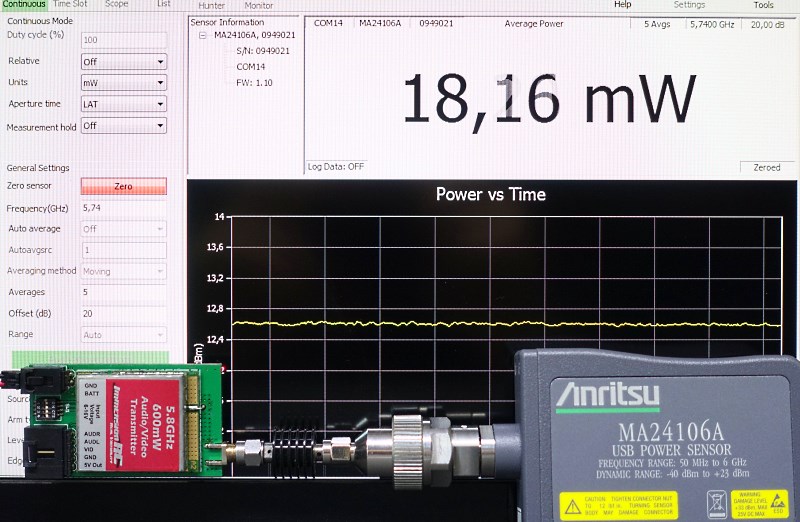
Since it so happened that the available microwave power is not enough, then for the normal transmission of the video stream you have to use a better antenna.
Found an old antenna for this 5.8 GHz band. I came across an antenna of the “helical gear” or “clover” type, that is, an antenna with a spatially circular polarization vector, in particular of the left rotation direction. In urban areas, it’s even good that not linear polarization of the signal will be emitted, but circular. This will facilitate and improve the picture of the struggle with the inevitable interference at the reception caused by reflection from nearby obstacles and buildings. The very first picture, in the lower right corner, schematically shows how the circular polarization of the propagation of the electromagnetic wave vector appears.
On a freshly calibrated vector network analyzer (VNA device), having measured the SWR and the impedance of this antenna, I experienced a certain gloom, as they turned out to be very mediocre. Having opened the antenna covers and having worked with the spatial arrangement of all 4 vibrators available there, with an indispensable condition for taking into account the permeability of the plastic covers, it was possible to completely eliminate parasitic reactivity of both capacitive and inductive nature. At the same time, it was possible to drive the active resistance to the central point of the Volbert-Smith pie chart (exactly 50 Ohms), at the selected frequency of the lower channel of the existing transmitter, namely at the frequency of the planned broadcast 5740 MHz:
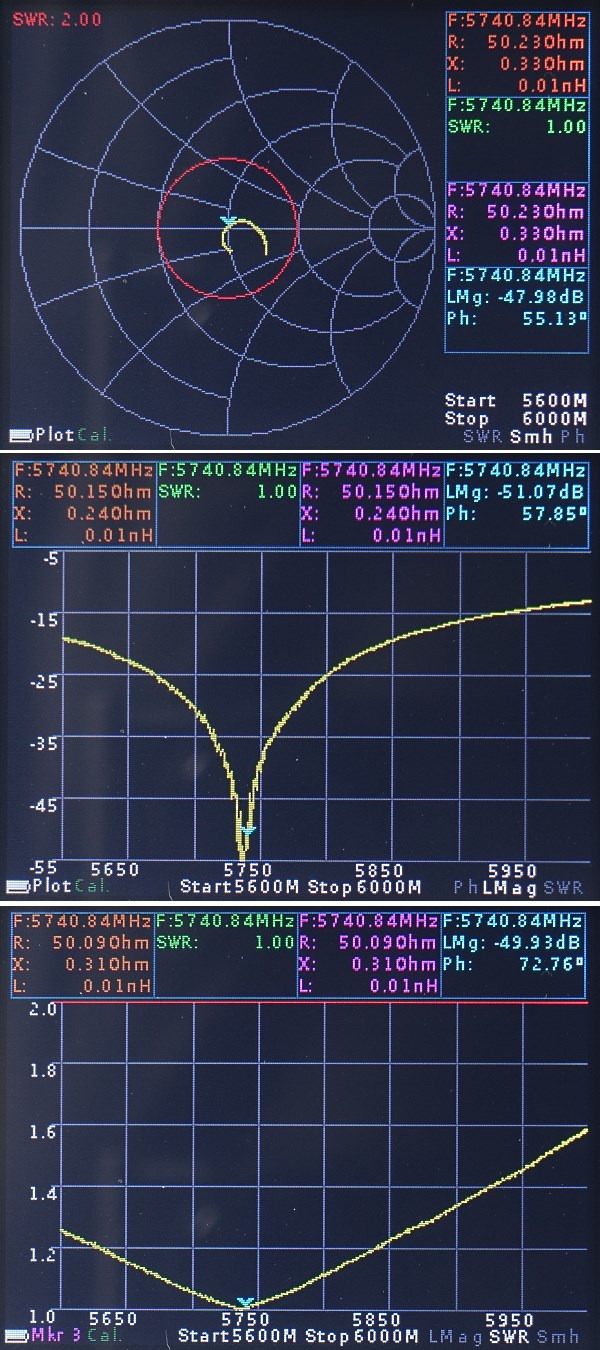
Accordingly, the level of reflected losses (on the average graph of the logarithmic magnitude) showed a microscopic value of minus 51 dB. Well, since there is practically no loss at the resonance frequency of this antenna, then the standing wave voltage coefficient (VSWR) shows perfect matching within the range of 1.00 - 1.01 (lower SWR graph), at the same selected frequency 5740 MHz (lower from the available transmitter channels).
Thus, all the available small power can be radiated into the radio without loss, which was required in this case.

Gradually, here is a set of additional accessories that was assembled for installation in a house:
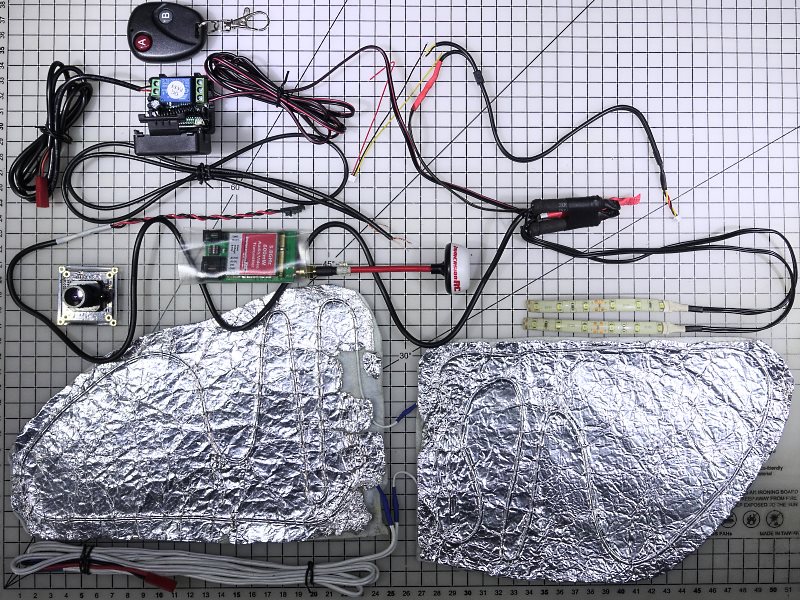
Here, in addition to the “warmers” (large and shiny plates at the bottom), a remote on / off system was also added, in the form of a radio remote control and a receiver-relay unit, tuned for mutual radio communication in the range of 315 MHz.
This is necessary in order not to constantly affect the sleeping cat with LED lighting and the radio transmitter turned on, even if it is extremely weak and placed outside the metal casing of the attic pediment.
The belly should breathe at rest, without artificial lighting, a flickering video camera nearby and malicious radiation penetrating into the living cells of the body. But for a short time, at any time on demand, it is possible to supply power from the remote control to the entire video network with diode ribbon lamps, quickly look at how the cofofacies are there, and immediately turn off the system.
From the point of view of electrical consumption, this is also an optimal and economical choice.
Cutting the LED strip of 12 diodes into two parts, I glued it and “sewed” it on top with the same harsh copper wire so that it would not break from a possible claw attack, and the lights should be:

A video camera with a video transmitter and a pair of LED strips powered to save through a pair of current-limiting resistors (390 ohms each), as well as a radio switch receiver, consume only 199 mA, when turned on from a second current source with a voltage of 12 volts . In the off state, in standby mode, there is only a radio switch, with standby consumption of only 7.5 mA, which is very small and is essentially masked against the background of losses in the consumption of electricity from the network.
Electric heating pads are also not manually turned on. For them, a step-down transformer is connected via a radio-controlled thermostat, a remote control with sensors of which is located in the house. So when it is already so warm, the heating system will automatically turn off, and only connect with a drop in street temperature.
The video camera was selected at least from open-frame, but with a fairly high light sensitivity of 0.0008 lux.
From an aerosol, it was coated with polyurethane varnish, for atmospheric protection and humidity drops, or even possible rainfall.
Coated antenna and camera after varnishing, rear view. Below you can see the red tape that has not yet been taken, covering the contacts of the main connector:

On the video camera, I had to rearrange the focus of the lens, to work in the near field, at a main distance of 15-30 cm. The camera body with the lens was simply pasted onto the thermocapron, right in the corner of the box.
The mounted part of the equipment (with wiring) on the box house, before sending the entire structure to the attic:

As you can see, here the “ceiling” of the box inside is reinforced and also “stitched” with copper, in case the cat decides to jump on top and trample on the “roof” of the house. For any scotch tape there will be few, even anti-vandal-reinforced.
Final tests on domestic cats, with the lighting and video turned on, showed the acceptable success of the concept:
1) With Siamese:

2) With tricolor:
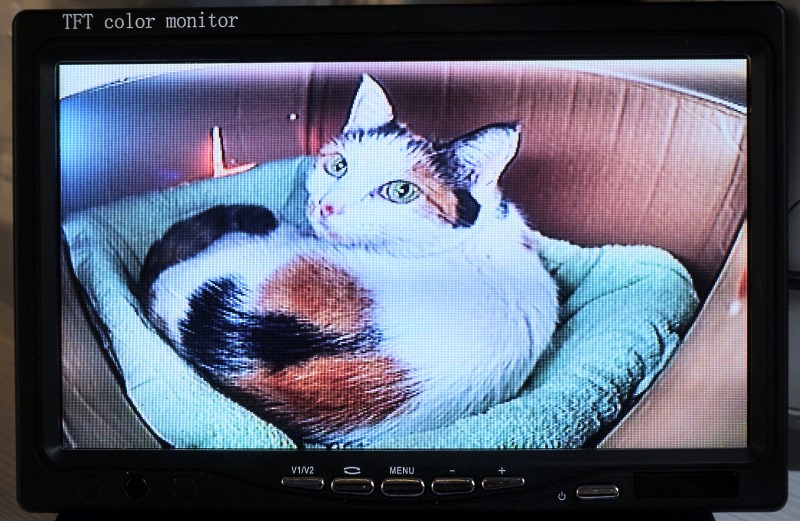
The video link, of course, is not Full HD resolution, but a regular analog SD (640x480), but for short control it is more than enough. There is no task to examine each hair, it is important to understand whether the object of observation is alive at all.
The day came for the whole structure to be installed on the accommodation facility, which was the old attic in a small barn with a local fireman. The attic turned out to be unattended, it was simply boarded up with nails and that’s it. I had to use pliers to tear out about 50 nails located along the perimeter of each of the two sheets of the pediment sheathing.
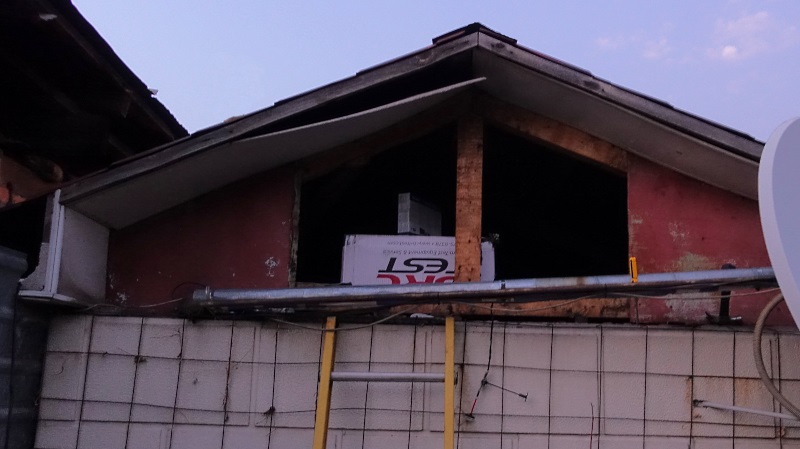
I expected the cat to be fearful and immediately run away from the noise of such “instrumental surgery” with the attic. But it was not there! He rushed at me, growling frantically, hissingly trying to inflict clawed injuries. Apparently, he had previously fought with local cats more than once and in battles he conquered this shelter. This is unknown.
For the first time I saw a similar lair of an attic cat. It is very dusty, old glass wool, caked to a flat state. It seems that this is not the first cat to live there. Nearby lay a pile of bird feathers, apparently the remains of eaten prey. Around the bunches of old and black cobwebs, a mass of dust, feathers and skeletons of small birds, in general an unsightly and terrible sight:


Steadily placing the “Kotodomik” under the roof and connecting the wiring, he twisted the old lining with the new screws.
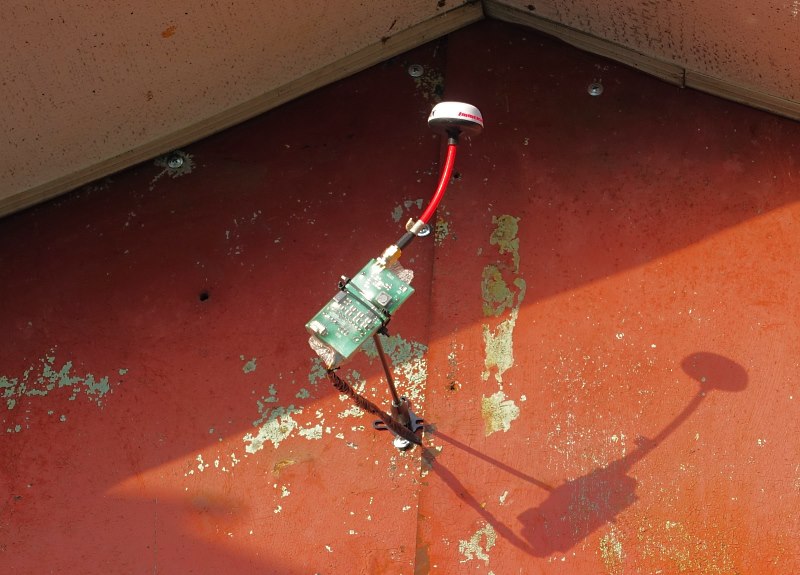
The video transmitter was immediately planned for removal from the metallized “shading” zone, so that an already very weak radio wave would not prevent anything from flowing around the yard, and, reflecting off the fence, to penetrate the window into the house, to the receiver with the monitor. The transmitter was previously tightened in heat shrink with sealed ends and mounted on a mast leg so that there were no conductive structural elements around the antenna at a distance of 1.5 - 2 Lambda. The curve antenna is visible in the photo, they say that it’s so messy? .. It’s not the “accuracy” here, but the carefully calibrated angle of the spatial orientation of the antenna, taking into account its radiation pattern. A little later, I had to open the pediment once again, as well as fix the transmitter in another way and bend the antenna with an optimal angle, including also to protect it from falling rain and hail precipitation with the wind, always breaking in exactly the same direction. Taking into account two factors at once, the coaxial feeder was bent, but there is no point in duplicating a similar photo.
An inquisitive reader may notice, why did you have to open the attic again? Because after waiting three days and periodically turning on the video control system, I never found a cat in a new house. Perhaps he is simply afraid to go in, or look inside. Perhaps he smelled strange cats from the box. And most likely the cat didn’t even understand that this is a house with a stove bench and you can climb into it by simply sliding your slot cover on your forehead. The reason is unknown.
I decided to lure him through the smell of sweets. Well, at least for familiarization, let him understand that there is no danger in the box, and that it’s really high. Itself would sleep, yes it is necessary to work. :)
In general, re-opening access to the attic, before entering the box and into the corridor of the box itself, as well as in the bed, I threw some pellets of feed with a fresh smell.
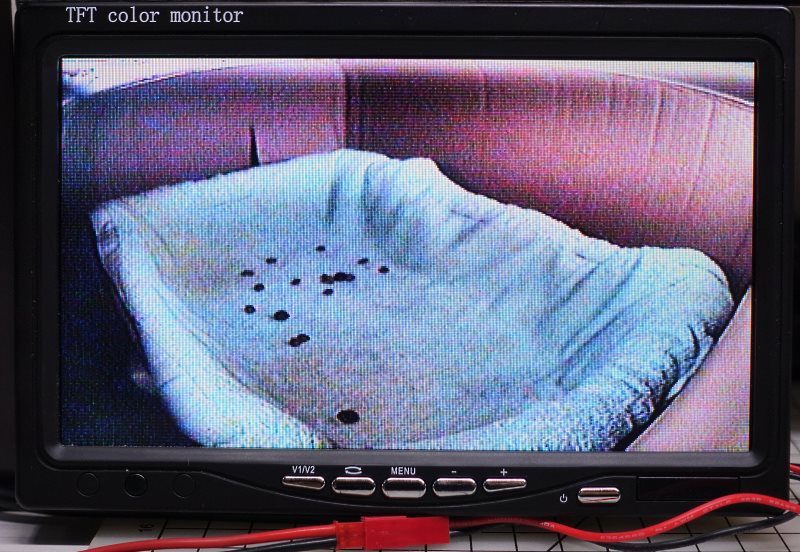
Hooray, the idea worked with a delicious trick!
After half an hour, the desired object very carefully and in small steps, but found the entrance to the house, visited it in full (and more than once), mumbling all the goodies there.
(in the photo there is now another monitor, with built-in radios and with green inscriptions)

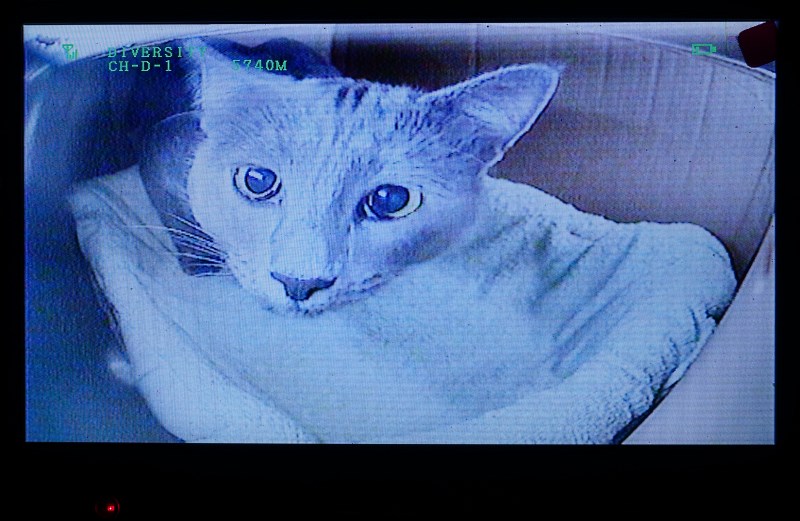
Thus, the attic cat got an equipped “house” with a Hi-Tech bias, and I have a plus in karma for a good deed, and in addition to the possibility of externally-controlled video control, what is there and how. One could capture the received video stream and organize its broadcast on the network. The result would be a webcam.
But since there is nothing fundamentally interesting here, and secondly there is no need to worry the cat, then there is no organization of capture with the broadcast.
But there were no mice, and this is definitely the merit of one of ours, and this kotan.
The territory of us and our neighbors has been completely cleared.
So kotofatsiy completely deserved a clean, warm and quiet couch for relaxation.
Let him live there as long as possible, in comfort and peace.
Good luck to the shy Devil with sad eyes:

All Articles